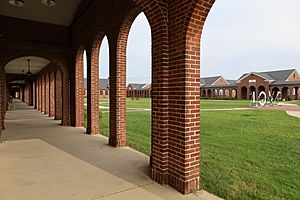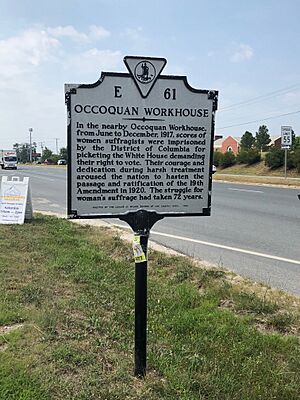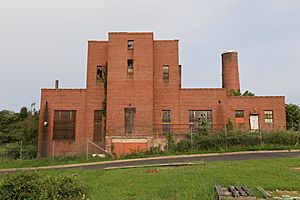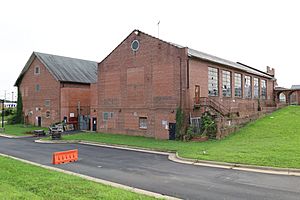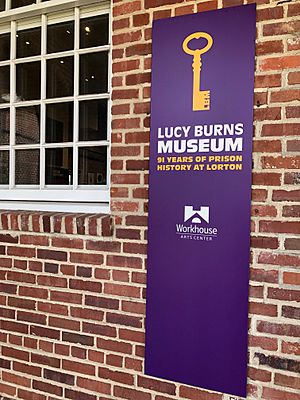Lorton Reformatory facts for kids
|
D.C. Workhouse and Reformatory Historic District
|
|
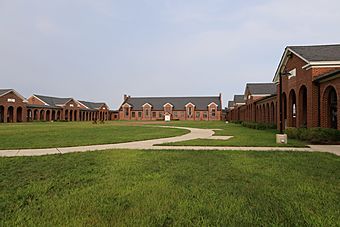
Main quad in 2020
|
|
| Lua error in Module:Location_map at line 420: attempt to index field 'wikibase' (a nil value). | |
| Location | Laurel Hill, Virginia |
|---|---|
| Area | 511.3 acres (206.9 ha) |
| Built | 1910 |
| Architect | Snowden Ashford; Albert Harris |
| Architectural style | Colonial Revival, Beaux Arts |
| NRHP reference No. | 06000052 |
Quick facts for kids Significant dates |
|
| Added to NRHP | February 16, 2006 |
The Lorton Reformatory, also known as the Lorton Correctional Complex, was a large prison complex. It was located in Lorton, Virginia. It opened in 1910 for the District of Columbia, United States.
The complex started as a prison farm called the Occoquan Workhouse. This part was for people who committed less serious crimes. In 1914, a reformatory was added. Later, from 1931 to 1938, prisoners built a 10-acre (4.0 ha) walled penitentiary. This section had higher security. In 1946, the complex became part of the District of Columbia Department of Corrections.
Over the years, the facility grew very large. It reached a peak size of 3,500-acre (1,400 ha). After 92 years of service, it was ordered to close in the late 1990s. The last prisoners left in November 2001.
Lorton also had a secret bunker from 1959 to 2001. This bunker held emergency communication equipment. It was meant for use if there was a war with the Soviet Union. Lorton Reformatory also had a Nike missile site, known as W-64.
Contents
History of the Lorton Reformatory
Near the reformatory is an old estate called Laurel Hill. It was built around 1790 by William Lindsay, a hero of the Revolutionary War. This house later became the home for the reformatory's superintendent.
In 1908, President Theodore Roosevelt asked a special group to study the bad conditions in Washington D.C.'s jail. This group suggested a new way to treat prisoners. The United States Congress agreed. In 1910, they bought 1,155-acre (5 km2) of land near the Occoquan River.
District architect Snowden Ashford drew the first plans for the workhouse in 1910. It opened in 1916. It was designed for less serious offenders. The buildings looked like classical, balanced dormitories.
From 1911, the complex had its own railroad. It was called the Lorton and Occoquan Railroad. It operated until 1977.
Women's Suffrage Movement at Occoquan
From June to November 1917, many important suffragists were arrested. These women were protesting for the right to vote. They stood silently outside the White House, calling themselves "Silent Sentinels". Many were held at the Occoquan Workhouse.
About 168 women, mostly from the National Woman's Party, faced very harsh treatment there. Some were even force-fed when they went on hunger strikes. The night of November 14, 1917, is remembered as the "Night of Terror". This is because the suffragist prisoners were treated so badly. The events at Occoquan Workhouse were shown in the 2004 film Iron Jawed Angels. This film tells the story of the National Woman's Party, Alice Paul, and Lucy Burns.
Building and Changes Over Time
The main prison buildings from the 1930s were built by the prisoners themselves. They even made the bricks from clay found near the Occoquan River. At first, only the highest security part had fences. But in the 1970s, more fences were added. This happened because local politicians wanted the prison closed. There were also more worries about prisoners escaping.
The Youth Center opened in 1960. It was for prisoners aged 18-22. It was created because of a law from 1950. This law aimed to help young people avoid future crime. The idea was for young prisoners to learn a trade or get an education. Then, their records could be cleared. The building was designed to look like a college campus. It had open dorm rooms. Over time, older prisoners were also housed there.
In its later years, Lorton became known as an old and very crowded facility. The last prisoners were moved out in late 2001. After a law passed in 1997, serious offenders from Washington D.C. started going to federal prisons instead.
On July 15, 2002, Fairfax County bought the property. This was allowed by a law passed in 1998. The law said the county had to plan to use the land for open space, parks, or recreation. The site has been part of the D.C. Workhouse and Reformatory Historic District since February 16, 2006.
Workhouse Arts Center
In 2002, the Lorton Arts Foundation wanted to give the old prison a new purpose. Their idea was to fix up the prison buildings. They wanted to turn them into a Cultural Arts Center. This new center would be called the Workhouse Arts Center. Many changes were needed to make this happen.
In 2004, the Fairfax County Board of Supervisors approved the project. Soon after, restoration work began. Walls were fixed, rooms were cleared out, and the tall fences around the property were removed.
In 2008, the Arts Center was ready for the public. It took four years to build and restore six buildings. These buildings were transformed into places for many different hobbies and activities. Now, people can learn ceramics, photography, painting, theater, film, and much more. Classes are offered in most of these areas.
The Arts Center also displays art by local and famous artists. Well-known artists have visited to teach and show their work. With over 800 different art classes, it has become a popular spot for people who love art.
Besides the Workhouse Arts Center, the old prison yard now has baseball and soccer fields. There is still a lot of open land. Plans are in place to add even more sports fields. Many people attend a yearly walk through the old grounds. Stages have been set up for local theater groups. Before the restoration began in 2004, tours were offered. Visitors could see rooms like the cafeteria, the warden's office, shower rooms, and cell dorms. The old guard towers still stand around the grounds.
Lucy Burns Museum
A museum opened in 2020 to honor suffragist Lucy Burns. She was a leader in the National Woman's Party. The Museum celebrates Women's Equality Day every year in August.
Notable People Held Here
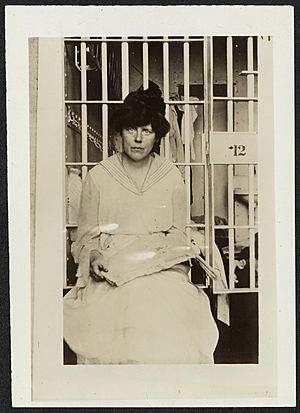
- Chuck Brown, musician, 1950s
- Lucy Burns, suffragist and women's rights advocate, 1917
- Iris Calderhead, suffragist and women's rights advocate, 1917
- Petey Greene, television and radio talk-show host, 1960s
- Alison Turnbull Hopkins, suffragist and women's rights activist, 1917
- Laura Houghtaling Ingalls, aviator, 1943
- Paula O. Jakobi, suffragist and women's rights activist, 1917
- Dora Lewis, suffragist and women's rights activist, 1917
- George Gordon Liddy, lawyer and actor, 1973–1977
- Norman Mailer, writer and activist, briefly in 1967
- Anne Henrietta Martin, suffragist and women's rights activist, 1917
- Alice Paul, suffragist and women's rights activist, 1917
- Elizabeth Selden Rogers, suffragist and education advocate, 1917
- Doris Stevens, suffragist, author, and women's rights activist, 1917
- Betty Gram Swing, suffragist and women's rights activist, 1917
- Amelia Himes Walker, suffragist and women's rights activist, 1917
- Ruza Wenclawska, suffragist and union organizer, 1914


